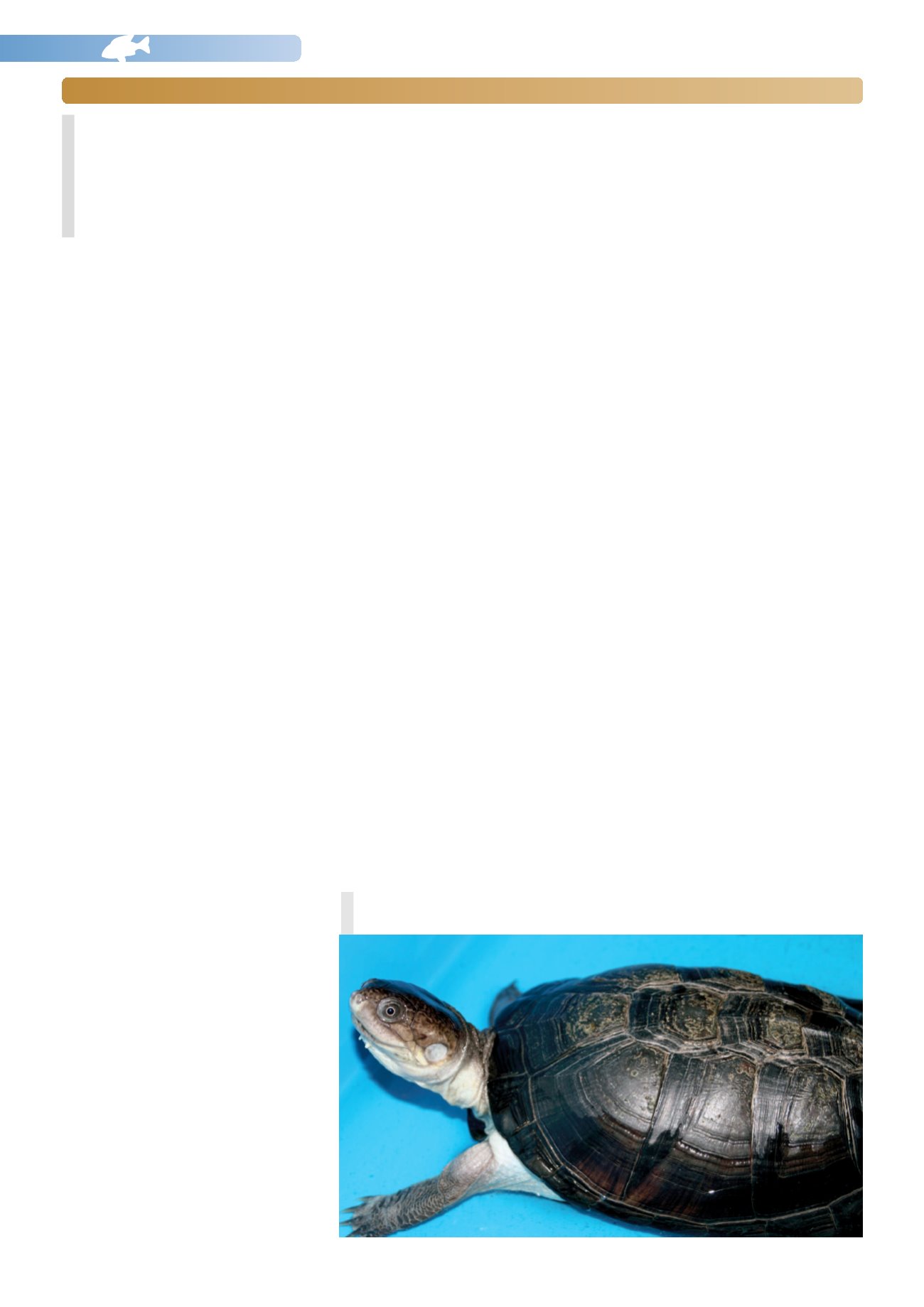
NEWS113
24
idelydistributed
Pelusios castaneus
is one of the
most widely distributed turtle species in
Africa. It is found along practically the
entire Atlantic coast of the Black
Continent: from southern Mauretania
across Senegal via The Gambia, Guinea-
Bissau, Guinea, Sierra Leone, Liberia, Ivory
Coast, Ghana, Togo, Benin, Nigeria,
Cameroon, and the north-western part of
the Central African Republic. In addition,
headingsouth fromCameroon thespecies
inhabits an area in Equatorial Guinea,
Gabon, Congo, and the DR Congo,
reaching thenorthernpart of Angola.The
species alsooccursonSaoTomé,an island
offshore of Gabon. There is also an
introduced population in the Caribbean,
specifically on the island of Guadeloupe,
where inall probability the speciesarrived
with slaves who had brought live turtles
with them as a food supply (these turtles
are eaten to the present day, more of
which anon).There is supposedly another
feral population in Florida, purportedly
derived from specimens releasedby apet
dealer.
Nomenclatural confusion
One reason for the rather rare articles in
hobbymagazines is undoubtedly the fact
that
Pelusios castaneus
is frequently
confusedwith
P. subniger
,which,however,
shares only a relatively small part of the
distribution of
P. castaneus
and in general
occurs livesmuch further south and east.
The two species are most easily
distinguishedby the nuchal scutes,which
together are about as broad as the first
vertebral scute in
P. castaneus
, but total
only 55-85% of the width of the first
It is often the commonest animal species that are the least reported.
Pelusios castaneus
is THE aquatic turtle of West Africa, and along with
Pelomedusa subrufa
(seeNewsno.85) themost frequently imported.
TheWestAfrican
MudTurtle
byChristophFritz,www.reptilia24.com
Turtles
W
Habitusof anapproximately15 cm longPelusios castaneus.Note the two littlebarbelson the chin.
All photos:FrankSchäfer
vertebral scute in
P. subniger.
Additional
differences are shown very clearly at
, a site that can
bemostheartily recommended toanyone
interested in
Pelusioscastaneus.
Pelusiosseychellensis,
notextinct...
.... because it never existed.At present 17-
18
Pelusios
species are distinguished, but
DNA analysis has shown that there are
probably more species than previously
thought.And thatmakes
Pelusios
themost
species-richofall turtlegenera!Butaword
of warning about one species that has
been regardedasextinct.Threespecimens
of
P.castaneus
havebeendeposited in the
Zoological Museum in Hamburgwith the
collecting locality erroneously given as
”Mahé,Seychelles”.But becauseof thevast
distance between the Seychelles and the
West African distribution of
P. castaneus
,
these specimensweredescribed as anew
species,
Pelusios seychellensis,
by Friedrich
S
IEBENROCK
(1853-1925), inhisdaya leading
world expert on turtles who worked in
Vienna.Since thenno furtherspecimensof
this species have ever been found on
Mahé and it was eventually declared
extinct. However, not long ago it proved
possible to extract DNA from the dried
type specimen, and this showed
unequivocally that
Pelusios seychellensis
was
P.castaneus
!
Habitat
TheWest AfricanMud Turtle is extremely
adaptableandoccurs inwatersofall kinds:
pools, ponds, lakes, rivers - it is at home
everywhere. In large parts of its
distribution thewaters inwhich it livesdry
up for 6-7 months of the year, and
P.
castaneus
spends this time buried in the
substrate. But there are also rainforest
forms (such as the specimens illustrating
this article) that havewater availableyear-
round.
P.castaneus
isalsoundemandingas
regards feeding. It eats insects, snails,
carrion, small fishes, and amphibians, and
sometimes also fruits and seeds. In
addition the species is very fertile. Large
femalescaneasilyproduce twoclutchesof
up to18eggsper year.
Endangeredornot?
Unfortunately nowadays it is almost
impossible to discuss turtles without
mentioning the endangered status of the
species. Because of its vast distribution
region and great adaptability
Pelusios


